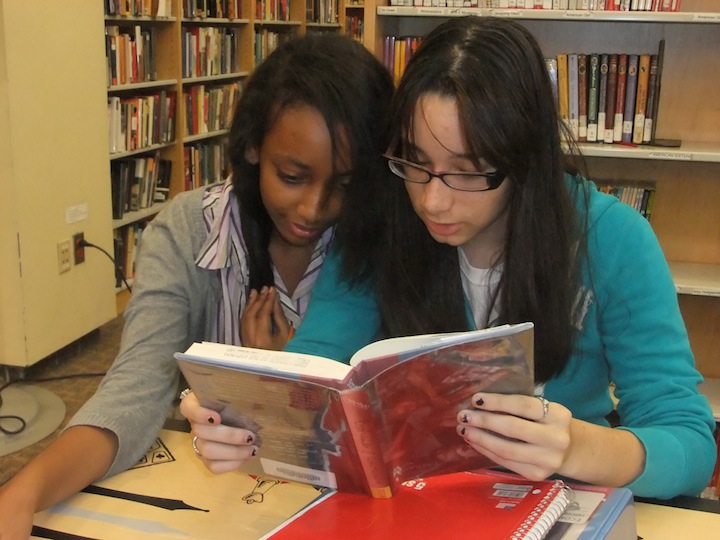On a recent field trip, I found Nashley and Bersabeh in a quiet corner of the library, sharing both a chair and a book. For an English teacher, this scene is pure gold: two ninth-graders, becoming friends, in the library, reading a book. I snapped a photo before squealing my delight. Then, I crouched down next to them to find out more about what they were reading.
The book was Boyfriends with Girlfriends, a young adult novel by Alex Sanchez. Bersabeh whispered confidentially that it was about bisexual teenagers. “Great,” I thought. It isn’t always easy to find young adult literature that features LGBT characters or addresses issues of sexuality and coming out. One of the reasons I took the class to the public library that day was to offer students a broader, more inclusive selection of books than my small classroom library could provide.
“But Ms. Melville,” Bersabeh continued. “Don’t you think there should be an age limit on books like these?” I asked her what she meant, and she explained that it didn’t seem appropriate for students under 15 to be reading books about sexuality. I knew that by “sexuality,” she meant LGBT sexuality, and that books about heterosexual relationships probably wouldn’t seem inappropriate to her. I was gathering my thoughts to respond when Nashley spoke up.

On a field trip to the public library, two students shared a book, a chair and perspectives.
“It’s not inappropriate,” she exclaimed. “They’re just bisexual. It’s not like they’re different.” For a moment, Bersabeh looked shocked by her new friend’s pronouncement.
"Ok, but there are little kids in here," Bersabeh protested.
Nashley laughed. "So what? Kids might be bisexual too."
This idea was strange to Bersabeh, but Nashley's tone was friendly and confident, welcoming Bersabeh to consider another point of view. I eventually joined the conversation, and the three of us talked about the age at which people recognize their own sexual identities - whether straight, bisexual, or gay. In the end, we concluded that it might happen at any age.
I was glad to be a part of the discussion, but I knew that Nashley was the real teacher in this situation. Her voice, as a peer and a friend, resonated more powerfully than mine could have. And I was so thankful that she chose to speak up!
One of the great advantages of a diverse school community is the opportunity for students to teach and learn from one another. In a classroom made up of students from different backgrounds, different parts of the city, and different parts of the world, spontaneous exchanges often lead to new insights about both similarities and differences.
For example, when a Muslim student explains why he will be out of school for Eid and how his family will celebrate, he offers a far richer answer than I could ever give about religious observances. Not only does this enrich my students’ learning with a kind of authenticity, but it also makes my job as a teacher a little easier and more interesting.
When these moments happen in my classroom, I’m proud of my students and proud to have helped create a classroom community in which they feel comfortable asking and sharing about their lives and cultures. But I’m also envious because the high school classes that I attended were largely homogenous and not very open to the kind of peer-to-peer learning I promote.
That exchange in the library was the highlight of my week. I got a great photo of two bright students reading together, learned about an exciting young adult novel, watched Nashley step up to tackle bias, and watched Bersabeh open her mind to learn from a friend. The photo reminds me to keep looking for ways that I can help my students learn – not just from me, but from each other.
Melville is high school English, Spanish and drama teacher in Pennsylvania.

0 COMMENTS